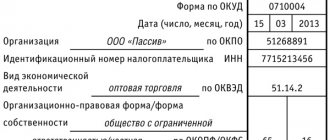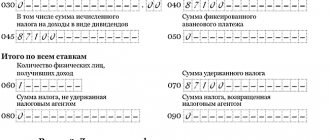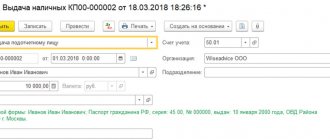Who must submit an income statement?
The legislation determines that accounting is the responsibility of every business entity that is registered with the Federal Tax Service as a legal entity.
In this case, no exceptions are made and the organizational form of the enterprise, the taxation system used, etc. are not taken into account. Accounting statements, and in their composition the report on financial results, must be sent to the Rostat and INFS bodies without fail.
Non-profit organizations and bar associations must also submit a profit and loss statement, Form 2, since this form is required to be completed by all entities.
Only citizens who have registered an individual entrepreneur as a legal form are exempt from this obligation. The same right exists for divisions of foreign companies. All these entities can prepare reports and send them to the authorities on a voluntary basis. Previously, reports did not have to be prepared and submitted to the relevant authorities only by companies using the simplified tax system.
The company may be classified as a small business. In this case, the provisions of the law provide for a simplified reporting procedure for such companies.
Attention! Even if you use this benefit, the company must prepare and submit accounting reporting forms, but in a simplified form. Companies must remember that this set of statements includes both a financial statement, Form 2, and a balance sheet, Form 1.
Contents of the report
The legislation of the Russian Federation defines a standardized document that reflects the relevant information - Form 2. The profit and loss statement compiled according to it includes the following main parameters: profit (losses) based on the results of sales of goods, operating revenue and costs, income and expenses arising as a result non-operating activities, the organization's costs of producing products at full cost (or production), commercial and administrative costs, net income from sales, income tax amounts, various liabilities, assets, net profit. In general, all this information allows us to fairly adequately assess the effectiveness of the company’s business model.
Which form to use – simplified or complete
An enterprise that does not meet the criteria for being classified as a small business must submit a balance sheet form 1 and a financial statement form 2 in full according to the provided reporting forms.
Organizations that have the right to use simplified reports are determined by the legislation “On Accounting”, these include:
- Companies classified as small businesses.
- Non-profit organizations.
- Participants in research and development projects on Skolkovo legislation.
Only these entities are given the right to prepare simplified accounting statements. Based on the prevailing circumstances and characteristics of the enterprise, they can independently decide on the use of reporting forms. They must consolidate this decision in the company’s accounting policies.
However, the use of simplified reporting is unacceptable for such business entities as:
- Firms whose reporting must be verified by statutory audit. They are determined by relevant legislation.
- Companies belonging to housing and housing-construction cooperatives.
- Credit consumer cooperatives.
- Microfinance companies.
- Government organizations.
- Parties and their branches in the regions.
- Bar associations, law offices, chambers of lawyers, legal consultations.
- Notaries.
- Non-profit enterprises.
Report and accounting documents
A profit and loss statement is an example of a document that, as we noted above, is included in the financial statements. It is comparable in importance to a source such as the Balance Sheet. However, the principles for drawing up these documents vary greatly. Thus, the balance sheet involves the inclusion of data as of a specific date. In turn, the profit and loss statement must contain information with a cumulative total - for the 1st quarter, half a year, 9 months, as well as the tax year.
The balance sheet and profit and loss account are prepared by all companies that maintain accounting records. The main task in drawing up the first type of document is to reflect information about the company’s property and sources of financing its activities. In turn, the profit and loss statement records the results of the company's activities and is used to assess the effectiveness of the enterprise's business model. Very often, both documents are submitted to the relevant government authorities at the same time. The mentioned sources are also extremely important, as we noted, for investors, as well as partner organizations planning to cooperate with the company.
Report submission deadlines
Financial statements, including balance sheet form 1, financial performance statement form 2, etc., must be sent to the tax authorities and Rosstat no later than March 31 of the following year. This temporary restriction exists only for the above listed bodies.
However, for statistics, it is possible that upon the occurrence of certain events it will be necessary to attach to the standard package an auditor’s report regarding the prepared annual report. The company must submit it to Rosstat within ten days from the date the auditors issued their report, but no later than December 31 of the following reporting year.
In addition, reports can be submitted to other competent authorities, as well as published due to the characteristics of the type of activity being carried out in accordance with legal norms. For example, companies that are tour operators must submit accounting forms to Rostourism within three months from the date of its approval.
The rules of law establish a different reporting procedure for companies registered on October 1. They can exercise their right and submit reports not until March 31 of the following year, but a year later.
For example, Rassvet LLC was registered with the Federal Tax Service on October 23. By decision of management, the company will submit its annual report by March 31, 2019, including information for the entire period of activity in one report.
Attention! Companies must file reports annually. Reporting, especially the financial performance report Form 2, can be presented not only annually, but also monthly or quarterly.
As a rule, in this case, its recipients are the owners who use it to make management decisions, credit institutions to process loans and credits, etc. Such accounting statements are called interim.
You might be interested in:
Reporting in 2021 for LLCs and individual entrepreneurs: deadlines, general table for LLCs, simplified tax system, UTII, unified agricultural tax
Should the data in the report be considered official?
The income statement is a completely official source. It is certified by the signatures of the organization’s management, and therefore cannot contain data that is presented for the purpose of deliberately distorting the idea of how things are going in the company. In some cases, firms involve external partners in the preparation of the relevant document in order to improve the quality of the analysis of the enterprise’s business model. This is carried out in the interests, first of all, of the company itself, which draws up the document - the attitude of other market players towards it often depends on how responsibly the organization approaches the formation of this report.
Where is it provided?
The laws establish that financial statements and the included form okud 0710002 profit and loss report are submitted to:
- To the relevant tax authorities - it must be submitted at the place of registration. In this regard, if an entity has separate divisions, it should not send its reports to the Federal Tax Service. Their information is included in the consolidated report of the parent company, which submits it to its legal address.
- It is mandatory to send reports to the territorial bodies of Rosstat if the company does not want to be fined on a fairly large scale.
- Owners and founders of the company - the annual report must be approved by them.
- To other government bodies, if this is directly stated in federal laws.
When concluding large contracts, partners can request financial statements from counterparties to confirm their reliability and financial solvency.
Management can decide to grant it or deny it. However, it must understand that this data can be obtained using special programs or partner verification services.
Attention! Also, quite often, reporting forms are requested by banks and other credit institutions when a company receives various loans. For example, if you need to get a loan to develop or start a business.
Significance of the document
A profit and loss statement is an example of the most important document in terms of analyzing the effectiveness of an enterprise's business model. This source also includes figures by which you can determine the profitability of a company or individual production (sales) areas.
The overall financial results of the company are thus characterized by the amount of profit, as well as the profitability indicator. The first criterion can be determined based on the dynamics of sales, rental of certain funds, exchange activities and other types of activities aimed at making a profit. The second one also depends on the level of costs.
Delivery methods
The financial performance report Form 2, included in the annual report, can be sent to the competent authorities using the following methods:
- Come to the institutions and submit the financial statements to the responsible person in person on paper in two copies. Sometimes they may also ask you to provide an electronic file of it. This method is not available for companies with more than one hundred employees.
- Send a valuable letter through post offices or courier services. The post office will require an inventory of this letter.
- Using electronic document management, you can submit annual reports to all specified authorities if you have a qualified electronic digital signature (EDS). For this purpose, a specialized program, tax authorities website, etc. can be used.
Features of working with a document
The finished profit and loss statement (a form with all the figures entered, as well as signed by the head of the company) is submitted to the territorial division of the Federal Tax Service at the place where the enterprise operates.
In some cases, it is possible to draw up a simplified document. Its structure involves indicating a smaller number of figures - for groups of individual articles, but without much detail of certain indicators. This opportunity is open to small businesses. Analysis of the profit and loss statement of large businesses, in turn, involves the study of a large volume of various indicators. This is necessary to carry out an objective assessment of the effectiveness of the organization’s development model - by managers, investors or creditors.
Form and sample for filling out a financial performance report in Form 2 in 2021
Financial results report form 2021 free download in Word format.
Download the 2021 financial results report form in Excel format.
Download the profit and loss statement form 2 with line codes in Excel format.
Download a simplified form of the profit and loss report in Excel format.
Profit and loss report form 2 sample completed download for free in Pdf format.
How to fill out a profit and loss statement form 2: full version
When filling out the financial results statement Form 2, you should follow a certain sequence.
The period under review is written under the title of the report. Further in the table, on the right, the date of compilation of the report is reflected. Below you need to write down the full or abbreviated name of the company, and in the tabular part - the registration code with Rosstat.
Then the TIN of the reporting company is reflected. Next, the name of the main type of activity carried out by the company is written down in words, and the OKVED code 2 is indicated in numbers.
The next line indicates the organizational form and form of ownership of the organization and puts the corresponding codes next to it. Next, the unit of measurement used is recorded.
The report itself is a table in which the company's performance indicators are reflected in terms, and in the columns - their value in the period of time under review and the previous one similar to it. Thus, a comparison of two periods of activity occurs.
Line 2110 should reflect the income received during the reporting period from all types of activities. This indicator is equal to the credit turnover on the account. 90.1. In this case, VAT should be removed from the revenue amount.
In the following lines of this subsection, you can decipher the amounts of income by type of activity. Small businesses may not do this.
Line 2210 reflects the amount of expenses incurred by the enterprise for the manufacture of products or the provision of services (work). The amount of the account turnover is reflected. 90.2.
At the same time, depending on the cost formation method used, the amount of expenses may include administrative expenses or not. If they are not included in the cost price, these amounts are reflected in line 2220.
If necessary, a breakdown of expenses by area of activity is also made here.
You might be interested in:
SZV-STAZH: who should take it, in what time frame, sample filling
Line 2100 determines the gross profit (loss), which is calculated as the difference between line 2120 and line 2210.
In line 2210, you should record the expenses incurred by the enterprise for the sale of products, goods, etc.
After this, in line 2200 the profit from sales is calculated, which is equal to the difference between lines 2100 and lines 2210, and line 2220.
Next, line 2310 indicates income received by the organization as dividends from other legal entities, other income from the participation of the company as a founder.
Line 2320 is used to reflect accrued interest on borrowed funds.
Line 2330 records the interest that the company must pay for the use of borrowed funds.
Line 2340 includes the amount of revenue received from non-core activities, including the sale of fixed assets, materials, etc.
Line 2350 reflects the amounts of expenses incurred for non-core activities, including the residual value of property sold and costs of materials sold.
Line 2300 calculates the enterprise's profit before tax. It is equal to the sum of lines 2200, 2310, 2340, from which the indicators of lines 2330,2350 are subtracted.
Line 2410 should reflect the income tax calculated on the basis of the relevant declarations. It is determined in profit declarations.
On line 2421 you should record the amount of the permanent tax liability or asset that affected accounting profit in the current year.
Lines 2430 and 2450 reflect discrepancies between the indicators of income and expenses for accounting and tax accounting, which are considered temporary, since their acceptance for accounting may occur in different periods. In this case, line 2430 reflects the amount of tax that will increase it in the future, and line 2450 will reduce it.
Line 2460 should reflect the amounts of indicators that were not considered and taken into account earlier, but nevertheless affect the company’s profit. For example, these could be various fines, a trading fee, etc. The indicator can take a positive value (turnover according to DT 99 is greater than turnover according to CT 99), or a negative value (vice versa).
Line 2400 is defined as the difference between line 2300 and line 2410, to which lines 2430, 2450, 2460 are added (subtracted).
Line 2510 records the change in the value of property based on revaluation, and line 2520 records other results that are not taken into account when determining profit.
Line 2500 reflects the adjusted profit indicator; it is equal to the sum of line 2400 plus lines 2510 and 2520.
Lines 2900 and 2910 are filled out as a guide and include information about basic and diluted earnings per share.
At the end, the document is signed by the manager and the date of approval of the document is set.
Specifics of defining indicators for a report
What should you pay attention to when determining indicators to include in a document such as Form 2? The income statement should primarily be prepared on an accrual basis. What does it mean? Revenue should accrue at the moment when the buyer or customer of the organization begins to fulfill obligations related to payment for goods or services. As a rule, they arise after products have been shipped or services have been provided. Documentedly, this is usually accompanied by the presentation by the customer of the necessary calculation sources.
So, now we know what Form 2 is - the income statement. Let us now study the nuances of drawing up this document. The form of the corresponding report is standardized and recommended by the Ministry of Finance. The document must be prepared before March 30 of the year following the reporting year - if we are talking about providing data for the tax year. It may be noted that the corresponding form of the profit and loss statement can be adjusted by the specialists drawing up this document. Certain lines can be deleted (for example, if there is nothing to reflect for certain indicators) or, conversely, added by employees of the relevant departments of the company.
How to fill out a simplified income statement line by line
The simplified form for okud 0710002 differs from the main one in that in the tabular part it has a significantly reduced number of reflected performance indicators.
It states:
- Enterprise revenue (line 2000).
- Expenses of a company in its normal activities.
- Interest paid by the company for the use of borrowed funds (line 2330).
- Other income.
- Other expenses (2350).
- Income taxes taking into account all deferred and permanent assets and liabilities.
- Net profit (2400).
Attention! Indicators are calculated in the same order as in a standard report. It’s just that, as a rule, organizations using this form do not have all other information.
Report Analysis
Analysis of an organization's profit and loss statement allows us to determine how effectively management carries out activities within the framework of certain business processes - production, supply, solving marketing and personnel problems. Possession of relevant information will allow the organization’s management or, for example, investors to assess how competently the company’s specialists and managers act, and to determine priorities in optimizing the enterprise’s development strategy. The profit and loss statement of an enterprise allows you to identify what factors influence the implementation of the company’s business model, what additional resources the company has to improve financial performance. This information is important both for management and for investors or creditors.
Common mistakes when filling out Form 2 of the balance sheet
Many errors when filling out this form are caused by arithmetic inaccuracies. Therefore, when filling out a report, it is best to use specialized complexes that perform all calculations automatically.
The most common mistakes made when filling out are:
- Quite often, when filling out the “Revenue” indicator, accountants forget to exclude the amount of accrued VAT from income.
- Another common mistake is to distribute income by type without taking into account the Accounting Regulations. Some professionals may include interest or income from participation in other organizations as other income.
- When determining the current tax, it is necessary to take into account the PBU “Accounting for income tax calculations”, which many do not do in practice.
- You also need to decipher some reporting indicators, which are given at the very end of the form in the form of a certificate. Experts quite often ignore this point.
How to fill out a document
Correctly filling out the financial results statement involves:
- reporting period, date of completion;
- full name of the organization, TIN, KPP;
- organizational and legal form, type of ownership;
- type of economic activity;
- codes according to all-Russian classifiers;
- unit of measurement;
- location.
Next, a table of 4 columns with key reporting values is filled in. It includes explanations to the report, line code (Appendix 4 of Order No. 66n), name and comparable values of indicators for the current and similar reporting period - year (clause 10 of PBU 4/99).
The financial results report is approved by the head of the organization.
In the report on Form 2 you must fill out:
- Revenue - line 2110: profitability from ordinary activities.
- Cost of sales - 2120: information on expenses for ordinary activities that formed the cost of goods, work or services.
- Gross profit, loss - 2100: data on the gross profit (loss) of the institution.
- Selling expenses - 2210: expenses directly related to the sale of goods, work or services.
- Management expenses - 2220: costs associated with managing the enterprise.
- Profit, loss from sales - 2200: income or loss from business activities.
- Income from participation in other organizations - 2310: income received from participation in the authorized capital of other institutions.
- Interest receivable - 2320: information about interest received, which is one of the types of income.
- Interest payable - 2330: expenses incurred as interest accrued payable.
- Other income - 2340.
- Other expenses - 2350.
- Profit, loss before tax - 2300.
- Current income tax - 2410: the amount of calculated tax from the tax return.
- Permanent tax liabilities - 2421.
- Other - 2460.
- Net profit, loss - 2400.
- The total financial result is 2500.
If the institution does not have actual numerical data, dashes are entered in the columns.







